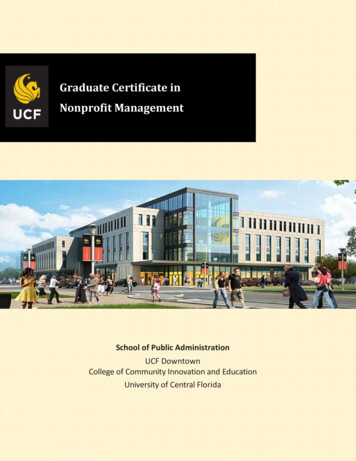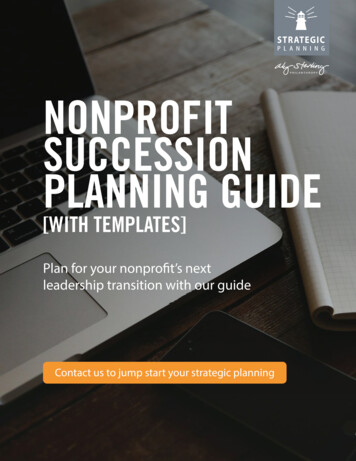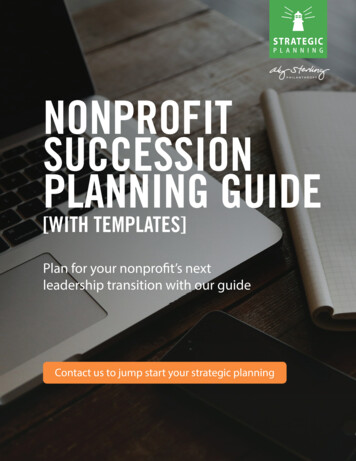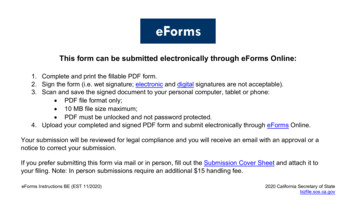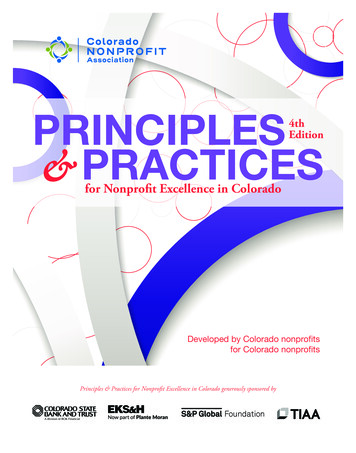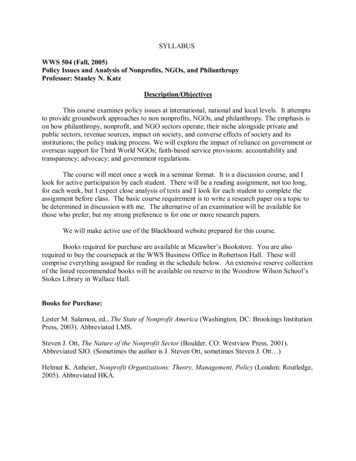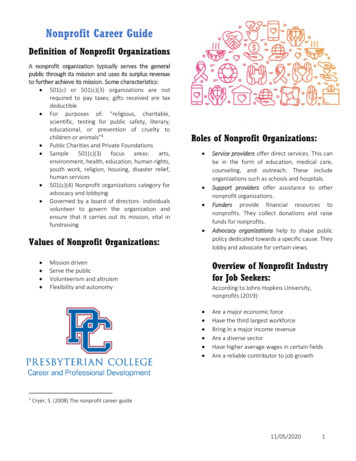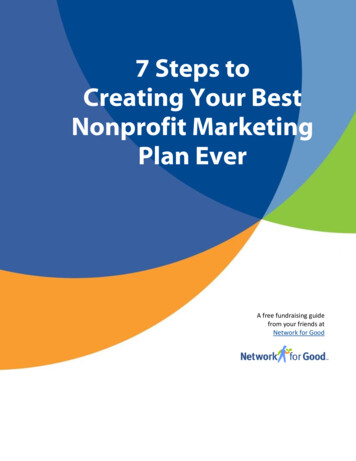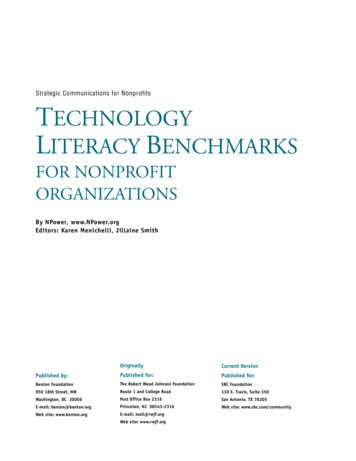
Transcription
Nonprofit BusinessPlan Development:From Vision, Mission andValues to ImplementationHealthcare Georgia foundation
“new quote here newquote here new quote”– Donato ClarkeNAESMAcknowledgementsHealthcare Georgia Foundation would like to recognize and thankthose who contributed greatly to this publication, including authorTerri Theisen, Theisen Consulting, LLC and Avatar Communicationsfor graphic design.Recommended Citation: Nonprofit Business Plan Development:FromVision, Missionand Values to Implementation, Terri Theissen,StrategicPlanningHealthcare Georgia Foundation, Publication #24, March 2008
What is Business Planning?Business planning is a vital component for any nonprofit organization. This planning is the blueprint that helpsto establish a foundation upon which the organization can focus on its vision, tailor its mission and incorporatevalues it deems essential to the organization’s success. As the nonprofit grows, a sound business plan can assist inpromoting a well-developed idea into a rewarding accomplishment. Likewise, a poor or mediocre business plan canimpede the growth of the nonprofit and hinder the organization from achieving desired results.Business planning is the process of gaining organizational agreement on long-term and short-term goals, and whenit is properly managed, can take an organization well beyond agreement on overall direction and goals. One of thebest by-products of a business planning process is increased engagement of the organization’s various stakeholders,including board members, staff, committee volunteers, members, donors, those served by the organization,community leaders, funders and others important to the organization. When stakeholders are brought together ina dialogue that produces decisions about organizational priorities, the process can ensure that the organization3will continue to have (or create) the impact that it desires to have on its community. A high level of stakeholderparticipation in the process also brings ownership of the final product, which should be a viable plan that willguide the next several years of an organization’s growth and development.Business planning covers all areas of theorganization, whether the organization is acommunity-based coalition or a non-profitcorporation. These areas may include missiondelivery (programs, services, policy change,advocacy), infrastructure development, marketingand communications, and resource acquisition.Business planning addresses critical questions facingan organization, including: What is our primary purpose? Where are we now? Where are we going as an organization –what are we trying to achieve?a. How will we get there?Business planning anticipates theinevitability of organizational change,and focuses on producing a plan that is Who are the key target audiences that we serve? What organizations are similar to ours?realistic, comprehensive and integrateda. What are they doing to accomplishtheir mission?across organizational functions – allb. How are they acquiring resources?while remaining true to the mission of theorganization. What are our core competencies? What do we do best? What could we do best? How much money do we need to accomplishour mission?
In order to answer these questions, there are several steps that are undertaken in the planning process:Step One: Creating the Situational AnalysisIn your situational analysis, you conduct an organizational assessment and an environmental scan sothat you can understand where your organization is at the current moment – a snapshot in time, if youwill, of how you are doing as an organization. In addition, this phase lets you know what other nonprofitsand community coalitions are doing that may be similar or duplicative of your efforts. You also exploretrends in your community’s demographics and economics, changes in the nonprofit sector that may affectyour work, and how the funding may or may not be changing for your work.Step Two: Developing A Picture of SuccessGaining agreement on organizational vision, mission and values underpins the planning process.Values guide the organization as it navigates change, providing a decision-making compass for internalstakeholders (board and staff) and sending a message to external stakeholders (those being served by theorganization and the community-at-large) about what matters to the organization.4In this facilitated discussion among your board and staff, informed by the knowledge that you havegained in your situational analysis, you will discuss your vision of the future: What does success looklike for your organization? During this step, you should look at your current mission, asking yourselvesabout the relevance of your mission to the community that you are serving, and determining your corecompetencies to accomplish your mission (which leads to the achievement of your long-term vision).Step Three: Accomplishing Your MissionThis phase involves the development of strategies to achieve goals, using metrics that determine whensuccess is achieved and assigning of accountability for implementation of the business plan. This is criticalto the planning process, and the organization is best served by securing agreement of the stakeholders (onthe elements of the plan) during the process.Gaining agreement onorganizational vision,mission and values underpinsthe planning process.
An important element of business planning is the allocation and acquisition of the resources required toimplement the plan, whether they be human (staff and volunteer) or financial (cash or in-kind) resources.Each of these aspects of the planning process will be discussed in greater detail in this publication. A visualrepresentation of a planning process might look like this:SituationalAnalysisMission / Vision / ValuesIssuesGoals5StrategiesAction PlansDocumentsImplement,Monitor, AdjustStep Four: ImplementationPeter Drucker, who has been termed the creator of modern management, once said that “A plan is uselessunless it immediately deteriorates into hard work.” This is the phase of planning where you make the plancome alive – and stay alive. Our motto should be “No shelf time for this plan!” We will explore how to dothis through the establishment of performance expectations based on the plan, and by using organizationalmeetings (including staff and board/coalition meetings) to maintain a focus on the goals and strategies thathave been deemed the highest priorities – high enough that they have been included in the organization’sbusiness plan.Healthcare Georgia foundation
Who is Responsible for Business Planning?In a nonprofit organization, the board of directors holds the ultimate responsibility for ensuring that a businessplan is in place, in partnership with the chief executive of the organization (executive director or CEO.) In anunincorporated organization, like a community coalition, the steering committee and/or officers or primary staffare responsible for initiating a planning process for the organization. The processes outlined in this document arethe same, with the last step prior to implementation being the approval of the business plan by either the boardof directors or the coalition’s membership. In both types of organizations, it is critical for the staff and volunteerleadership to work together to create the plan, as both groups will need to work together to make the plan come tolife and realize the full promise of the organization’s mission.Business Planning: The Steps in the ProcessStep One: Situational Analysis6An organizational assessment is a study of an organization’s practices and policies meant to uncover theorganization’s strengths and challenges*. This comprehensive assessment identifies the organization’s strengths,weaknesses, opportunities and threats (SWOT), and offers thoughts and recommendations on future organizationaldirection. Strengths and weaknesses are internal to the organization, and opportunities and threats are external.A proper SWOT analysis will cover program and service delivery, evaluation of the organization’s programs andservices is conducted, operational and financial management practices, governance and decision making, andutilization of technology.An organizational assessment is often supported by an environmental scan (discussed on pages 7 & 8).Here are some questions to consider when conducting your SWOT analysis:SWOTStrengths: What do we do exceptionally well? What advantages do we have in our marketplace (i.e. numberof people affected would be one!) What valuable assets and resources do we have (human or financial)? Whatwould those we serve say are our strengths? What do we have that our competitors (other nonprofits raisingmoney or serving similar clients or constituents) do not have?Weaknesses: What could we do better? What are we criticized for or receive complaints about? Where are wevulnerable?Opportunities: What are we aware of but have not been able to address? Are there trends on which we cancapitalize in our marketplace?Threats: Are any of our weaknesses likely to make us critically vulnerable, i.e. unable to operate? What are ourroadblocks? What are our competitors doing that we are NOT doing?*(Note: See Healthcare Georgia Foundation’s publication on organizational assessment for detailed informationabout conducting an organizational assessment.)Strategic Planning
Strengths (Internal)Weaknesses (Internal) Knowledge of the issue Lack of experience with fundraising Passion for the cause Limited human (volunteer & staff)resources Past successOpportunities (External) Established collaborative partnerships withother nonprofits and coalitions inthe community Expansion of programsthroughout geographic areaThreats (External) Competition from other nonprofitsand coalitions for funding Competition from others to deliverprograms and services to targetpopulation groups7 Lack of relationships with thelocal business and civic communityAn environmental scan is the acquisition and use of information about events, trends and relationshipsin an organization’s external environment. An environmental scan takes a critical look at the trends facingthe organization in its field of work, in its community, and in the area of future funding. The results of theenvironmental scan can provide information about potential future scenarios and options available to theorganization for its growth and development. An objective scan of the marketplace that your nonprofit or coalitionis operating in can provide a “fresh pair of eyes” and help your organization to be as agile as possible whenresponding to external trends in the marketplace. Examples include the possibility of priority shifts among fundingsources, or the sheer number of nonprofit organizations now operating in any community. In the United States,there are more than 1 million 501(c)(3) organizations, as of this writing, and information about organizations thatare similar to yours and how they are offering programs and services in the community can be very valuable informing your future plans. An environmental scan usually includes: demographic information about the target population groups served by your nonprofit or coalition; place-based data including information about where other nonprofits and coalitions are providing similarservices and programs in your geographic area; information about the funding landscape, including trends among potential individual, corporate andfoundation donors; specific information about your particular issue or cause, including what is happening in other areas of thecountry that may be applicable to your work.Healthcare Georgia foundation
This information can support the decision-making of the staff and volunteer leadership, as they prioritize thefuture activities and direction of your organization. An organizational assessment and environmental scan can beprepared by internal (staff or volunteer) or external (consultant) resources. The most important thing is that properdata are gathered and utilized in the process. Once the report(s) is/are completed, it should be discussed throughoutthe organization – with staff, with board members or coalition leadership, and with other key stakeholders. Thiscan be accomplished in a facilitated setting like a retreat or in a regularly scheduled meeting. Some suggestionsfor organizing that discussion, no matter what setting it takes place in, are:1. Send the complete report(s) to all discussion participants ahead of time, preceded by an executive summary (nomore than one page) for each report that you include. Send it at least one week in advance of the scheduledmeeting to allow time for participants to absorb the material.2. Present the highlights of each segment of the report, followed by discussion of that particular segment of thereport only. This will allow for a more focused discussion of that particular section of the report, and allowdiscussion participants the opportunity to air their views on that particular topic.3. Provide questions to focus the discussion:8a. How can we utilize what we have just heard to make our organization and/orprogram stronger/better?b. Is there anything that we have learned that might make us change what we are doing?If yes, what changes do we recommend?c. How soon do we need to make changes in order to stay ahead of the trends thatwe are hearing about?4. Determine the next steps, which should include prioritizing the recommendations contained in the report(s) andthe acceptance of that prioritization by the staff and volunteer leadership. These recommendations can be usedto inform the business planning process – as a “touchpoint” for the next steps in the process.Step Two: DEVELOPING A PICTURE OF SUCCESSA mission statement shouldbe one sentence, and a visionstatement should be onesentence; if these statements arelonger than that, they becomedifficult for all organizationalstakeholders to remember.Strategic PlanningIn “Leaders,” Warren Bennis and Burt Nanus conclude, “Leaders articulateand define what has previously remained implicit or unsaid; then they inventimages, metaphors, and models that provide a focus for new attention. By so doing,they consolidate or challenge prevailing wisdom. In short, an essential factor inleadership is the capacity to influence and organize meaning for the members ofthe organization.”If we follow the logic of Bennis and Nanus, we know that we need powerful,brief statements that succinctly communicate to our stakeholders what it is thatwe are doing (mission), where we are going as an organization (vision), andwhat we stand for as a group of individuals who come together to work on acommon issue (values). A mission statement should be one sentence, and a visionstatement should be one sentence; if these statements are longer than that, they
become difficult for all organizational stakeholders to remember. Conciseness incommunication is important so all volunteers and staff in the organization canbe vigilant about using the mission and vision statements as the touchstones fordecision-making, which is how effective organizations use mission statements.What is Vision?Vision is a coherent and powerful statement of what an organization can – andshould – accomplish in the future. It is part emotional and part rational. It is emotionalbecause it forces people to dream and have a sense of imagination and rational becauseanalysis of issues facing an organization are a necessary part of the vision process.Vision is a view of the future that everyone can believe in.Vision is a coherent andpowerful statement of what anorganization can – and should– accomplish in the future.Vision is a guiding image of success – what does success look like? The mission statement provides a blueprintfor an organization’s work – the what, why, and how of what it does – and – the vision is the realization ofthat mission.9What is Mission?A mission statement answers three key questions: What do we do? For whom do we do it? What is the benefit?A vision statement, on the other hand, describes how the future will look if an organization achieves itsmission. A mission statement gives the overall purpose of an organization, while a vision statement describesa picture of the “preferred future.”Vision looks forward; mission looks at today.Key Elements of a Powerful Vision Statement Ideals are set high – it is about a “better future” It inspires enthusiasm and encourages commitment It is ambitious It is easily understood and can be remembered It provides focus on what is important to the organization It promotes changeHealthcare Georgia foundation
Utilization of Vision and Mission StatementsFor a vision statement to have an impact on an organization, it must be widely disseminated anddiscussed, and it must be referred to frequently as a means of determining appropriate responses to the varioussituations that confront the organization. Only if the vision and mission statements are used as the basis fororganizational decision making and action will it have been worth the effort of creating them. Once thesestatements are created, we recommend revisiting them every 5-7 years to ensure that they are still relevant tothe current environment and the work that the organization originally set out to do.Examples of Vision StatementsThere will be a personal computer on every desk running Microsoft software. (Microsoft) Children and youthare healthy, safe, and prepared for a productive adulthood. (Children’s Bureau)Families are able to provide a healthy and supportive environment for their children. (Georgia Academy)10Our company’s vision is to help people live longer, healthier and happier lives. (CVS)Year after year, Westin and its people will be regarded as the best hotel and resort management group in NorthAmerica. (Westin Hotels)A world without Alzheimer’s disease. (Alzheimer’s Association)Finding Cures. Saving Children. (St. Jude Research Hospital)A world without arthritis pain. (Arthritis Foundation)Only if the vision andmission statements areused as the basis fororganizational decisionmaking and action will ithave been worth the effortof creating them.Strategic PlanningExamples of Mission StatementsTo preserve and protect human life. (Merck)To be a catalyst for change in the lives of women and girls. (Atlanta Women’sFoundation)To elevate women to positions of power and influence in the commercial realestate industry. (Commercial Real Estate Women Atlanta)To advance the health of all Georgians and to expand access to affordable,quality healthcare for underserved individuals and communities. (HealthcareGeorgia Foundation)
What is a Values Statement?Values represent the core priorities in how an organization chooses to operateand represent itself to stakeholders, both inside and outside the organization.Values statements should: Be understood by people internal and external to the organization; Represent the organization’s mission; Represent how the organization operates and deals with people; Be adhered to by the board of directors, coalition leadership, volunteers andstaff as decisions are made on behalf of the organization.Values statements should:Be understood by people internal andexternal to the organization;Represent the organization’s mission;Represent how the organizationoperates and deals with people;Be adhered to by the board of directors,coalition leadership, volunteers andstaff as decisions are made on behalfof the organization.Examples of Values Statements Responsibility and Integrity-Participate – say what you believe-Work to know who will do what and by when11 Leadership Model our corporate vision, mission, and values in all that we do(The Management Assistance Program for Non Profits)-Commitment to Planning-Flexibility and Adaptability-Creativity and Resourcefulness-Delivery on What is Promised-Energetic and Enthusiastic-360 Thinking-Performance with a Sense of Urgency-Open Forthright Communication (Gemma) Our work is about people and science. (Alzheimer’s Association) Pride Purpose Passion(Arthritis Foundation)Healthcare Georgia foundation
Development of Your Mission, Vision and ValuesVision, mission and values are best developed by the leadership of the organization. Senior staff and board (orcoalition) leadership should come together for a discussion grounded in the following questions. This meeting canbe a special retreat (in fact, the same retreat in which the situational analysis is discussed) or in a board meeting.Allow three to six hours to develop and agree on the mission, vision and values of the organization. This can,as previously noted in the situational analysis discussion, be facilitated by a combination of internal staff andvolunteers in the organization, or by an outside consultant.Mission: What is the purpose of our organization? What do we do every day to improve our community? What do those we serve consider the most important aspect of our work? What do they need from us most?12Vision: How would the world be changed or different if our organization succeeded in our mission? Dare to dream the possible – how do we define “success” for our organization? What will we need to achievein order to feel that we have accomplished our mission? What makes our organization unique (among our peers and competitors)?Values: What are the key values that our organization should embrace? How should we, as the leadership of the organization, hold ourselves accountable for living by these values?Vision, mission and valuesare best developed bythe leadership of theorganizationStep Three: Accomplishing Our Mission Establishment of measurable goals; Determination of strategies to achieve goals, with defined timeframes; Allocation and acquisition of human (staff and volunteer) and financial resourcesGoals are statements describing what an organization wishes to accomplishon behalf of its mission. (In turn, accomplishing the mission leads to achievingthe organization’s vision.) Goals are the “ends” toward which energy andefforts are directed.Strategic Planning
An easy acronym for goal-setting is SMART, which stands for:Five measurable goalsseem to be the maximumnumber that mostorganizations can manage. Specific – What do we want to accomplish, exactly? An example of a generalgoal is “we hope to improve our top of mind awareness among the public.”An example of a specific goal is “60% of the public will be aware of ourorganization by the year 2015, as measured by public opinion polling.” Measurable – The second goal above is measurable, meaning your organizationwould know when you had achieved the goal. Ask yourself questions like “Howmany?” “How much?” “How will we know we achieved it?” when determining ifa goal is measurable or not. Attainable – The most important question to ask to ensure if a goal is attainable or not is “Can we figure outways to make it come true?” If an organization can figure out the ways to make it come true – the strategies –then it will be able to attain the goal within a timeframe that allows the organization to work toward the goal,even if it is several years in the future. Realistic – To be realistic, a goal must represent something you are willing and able to work on as anorganization. Remember that goals that are not sufficiently challenging represent “low motivation” inorganizations. Frequently, it is easier to achieve goals that appear more aggressive because they capture theimagination, energy and excitement of the people within the organization and these stakeholders are motivatedto work toward the goal. Timely – Without a timeframe, there is no sense of urgency to reach a goal.13How many goals should an organization have? Five measurable goals seem to be the maximum number thatmost organizations can manage. Jim Collins, in Good to Great, observed that organizations with more than fourgoals rarely succeeded in accomplishing them all, even when they were measurable.When your organization has agreed on its goals, test yourself by asking:Is each goal measurable and does it have a timeframe, a date by which we will achieve it?Does each goal move us closer to achieving our mission?If you can answer yes to these two questions about each of the goals you have established, you are ready to moveto the action planning phase, which involves creating the strategies that you will employ to reach the goals. Strategiesare descriptions of what must be done to meet the goals. They are clear, specific statements of what you plan toaccomplish. As depicted in the following diagram, the strategies lead directly to “action” and the documentation thatwill allow the organization to begin the process of implementation (step four in our planning process.)Healthcare Georgia foundation
Each goal may have several strategies, which is really the organizational “to do” list that must becompleted in order to achieve the goals. Each strategy must have its own timeframe in order to assignaccountability for its completion and determine what resources might be needed to work on it.An example document might look like this:SituationalAnalysisMission / Vision / ValuesIssuesGoalsStrategies14Action PlansDocumentsImplement,Monitor, AdjustOrganization NameBusiness Plan, egic Planning
Goal #1:Strategy #1.1:Timeframe toAccomplishStrategy: StartDate? CompletionDate?Accountability– Staff Positionand/or Board(or Coalition)CommitteeResources Required:Financial (Cashor In-Kind?) andHuman (Volunteerand/or Staff)Measure of Successfor this Strategy(an interimbenchmark alongthe way to theoverall goal)Strategy #1.2:Strategy #1.3:Goal #2:Strategy #2.1:15Strategy #2.2:Strategy #2.3:A chart like this, along with a narrative explanation or executive summary of your business plan (which is notalways necessary), provides the management framework for the board and the staff to work on the business planand “keep it alive.”When your plan is complete, whether it has been assembled by a planning committee, or the board and staffduring a retreat, or by the committees of the organization over a period of months (each working on one aspect ofthe organization’s operation), or by a combination of all of these methods, you are now ready to present the plan tothe board (or the coalition’s leadership group) for approval so you can move forward with implementation.Healthcare Georgia foundation
Step Four: ImplementationBy now, you will have spent at least a few months on the preparation and development of your businessplan, and are ready to move into the implementation phase: putting in place all of the exciting ideas that yourplanning process has generated. The chart below demonstrates how an organization moves through the variousphases of planning into implementation.Overall Organizational Plan: Vision,Mission, Goals, Strategies toAccomplish GoalsWhat Does SuccessLook Like?16Operational Plan: Action Steps,Timeframes, Accountability,Required Resources (Human & Financial)Dashboard Measurement System(of Plan Elements) forBoard & ManagementPerformance Management &Expectations (for Staff &Board Committees)We have all heard the adage, “What gets measured, gets done.” To that end, we have some suggestionsfor keeping the plan alive and making the most of all of the generative thinking that your planning processhas produced: Each strategy in the plan should “belong” to at least one staff position, and be placed prominently inthat staff position’s performance expectations, and the subsequent performance evaluation at year end.In addition, each strategy should be placed in the annual work plan (that “to do” list) for an appropriatecommittee of the organization or of the board. This will bring accountability to staff and volunteer work onthe plan.Strategic Planning
The “Resources Required” column in the business plan should becomethe basis for the organization’s annual budget, answering the importantquestion: How much money do we need to do our work? (This is differentfrom the question many organizations ask: How much money can we“get” to do our work?) It is much more effective to start from a point ofknowing what resources are actually required and making the case forthose resources to individual, foundation and corporate donors, even if thisis over a period of years.Singular focus in anorganization will bring thealignment that organizationsneed to be successfuland remain focused ontheir vision, mission andachievement of theagreed-upon goals. Each meeting agenda throughout the year is developed based on thestrategic plan, whether it be a board meeting, a coalition meeting, acommittee meeting, a staff meeting, or a staff performance review meeting.The meeting agenda should focus on business plan goals and strategiesand the measurements for those goals and strategies. This singular focusin an organization will bring the alignment that organizations need tobe successful and remain focused on their vision, mission and goal achievement. (This may require arevision of how organizational meetings are conducted, including using visual indicators of performance,such as “stoplight analyses” in which the business plan is distributed with red, green, or yellow assignedto each strategy to denote the progress made on each strategy. The discussion then focuses on how theorganization can provide resources to support the successful achievement of the plan.)17 Every 18 months to two years, hold an extended board meeting or a retreat (at least 4-6 hours withboard and management staff present) and review in-depth the goals and strategies contained in the plan.Determine if any changes are in order by focusing the conversation in an evaluative manner: Did we dowhat we said we were going to do? Did we do it in the way we said we would do it? Do we need to alterour strategies in order to meet these goals?Form follows function, and the next diagram illustrates the implementation
Business planning is a vital component for any nonprofit organization. This planning is the blueprint that helps to establish a foundation upon which the organization can focus on its vision, tailor its mission and incorporate values it deems essential to the organization's success. As the nonprofit grows, a sound business plan can assist in
